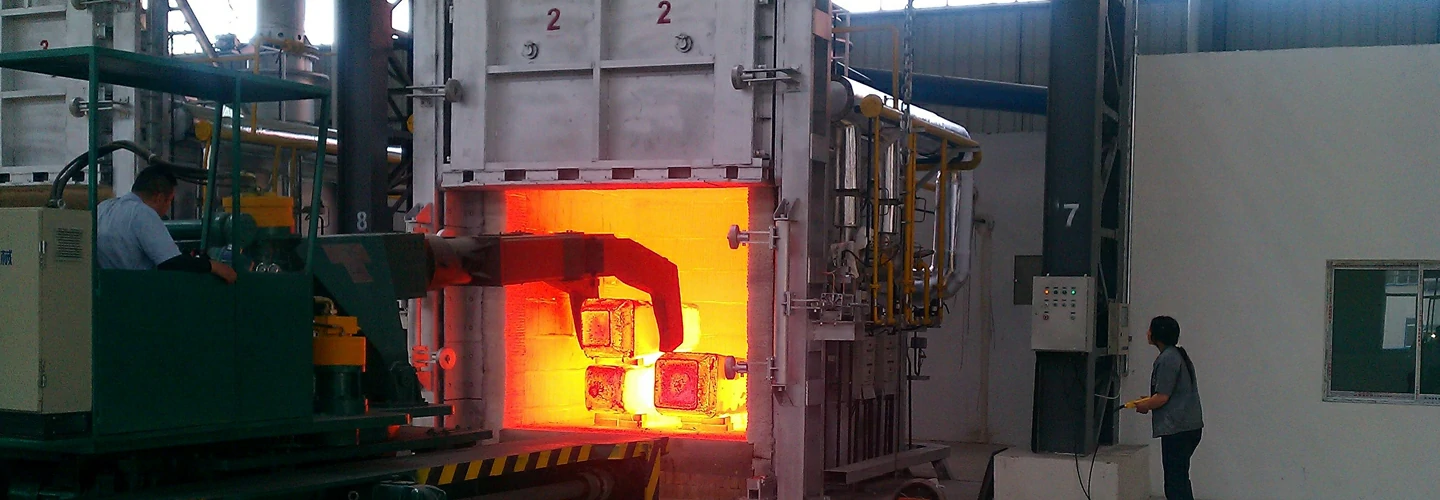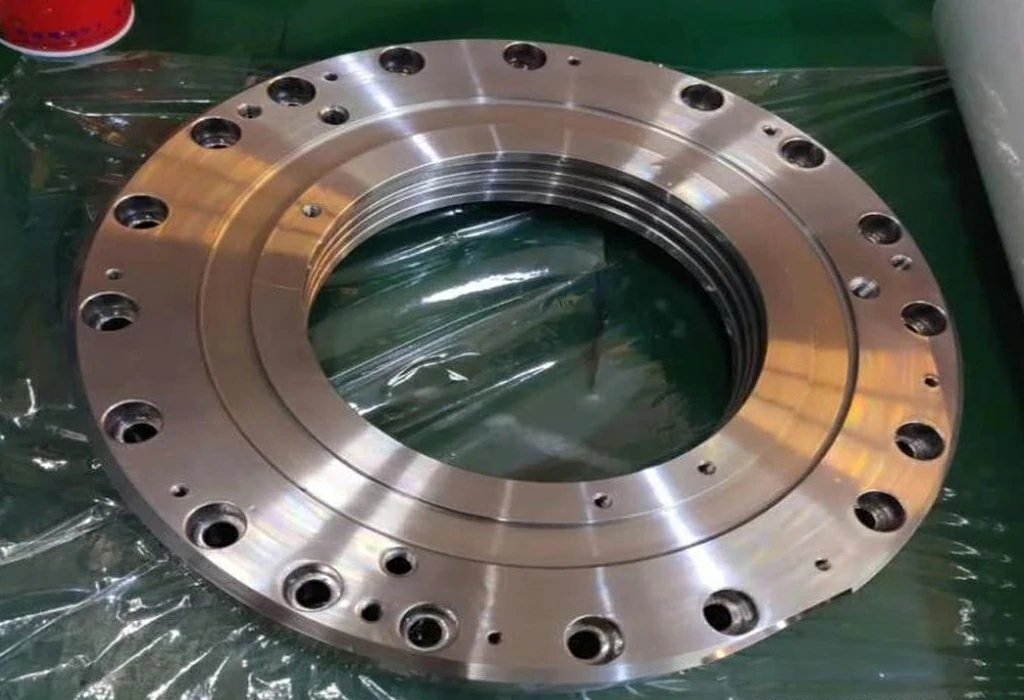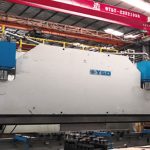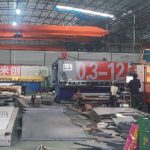
Titanium Forging
Forging is a forming and processing method that applies external force to titanium metal billets (excluding plates) to produce plastic deformation, change size, shape and improve performance to manufacture mechanical parts, workpieces, tools or blanks. In addition, according to the movement mode of the slider, there are also vertical and horizontal movement of the slider (for forging of slender parts, lubricating cooling and forging of parts for high-speed production), and the compensation device can be used to increase the movement in other directions. The above methods are different, and the required forging force, process, material utilization, output, dimensional tolerance and lubrication and cooling methods are different, and these factors are also factors that affect the level of automation.
According to the movement mode of the billet, forging can be divided into free forging, upsetting, extrusion, die forging, closed die forging and closed upsetting. Since there is no flash during closed die forging and closed upsetting, the material utilization rate is high. Complex forgings can be completed with one or several processes. Due to the absence of flash, the stress area of the forging is reduced and the required load is also reduced. However, it should be noted that whitespace cannot be completely restricted. Therefore, the volume of the blank should be strictly controlled, the relative position of the forging die should be controlled, and the forging should be measured to reduce the wear of the forging die.
According to the movement mode of the forging die, forging can be divided into rotary forging, rotary forging, roll forging, cross wedge rolling, ring rolling and skew rolling. Rotary forging, rotary forging and ring rolling can also be processed by finish forging. In order to improve the utilization rate of the material, roll forging and cross-rolling can be used as the front process of slender materials. Rotary forging, like free forging, is also partially formed. The advantage is that it can be formed even if the forging force is smaller than the forging size. This forging method, including free forging, expands the material from near the die surface to the free surface during processing, making it difficult to ensure accuracy. Therefore, by controlling the movement direction and forging process of the forging die with a computer, products with complex shapes and high precision, such as forgings for multi-variety and large-sized turbine blades, can be obtained with low forging force.
In order to obtain high accuracy, care should be taken to prevent the bottom dead center from overloading, and to control the speed and mold position. Because these affect forging tolerances, shape accuracy and die life. In addition, in order to maintain the accuracy, attention should also be paid to adjusting the slider guide clearance, ensuring rigidity, adjusting the bottom dead center, and using auxiliary transmission devices.
Titanium forging materials are mainly pure titanium and titanium alloys of various compositions. The raw state of the material is bar, ingot, metal powder and liquid metal. The ratio of the metal cross-sectional area before deformation to the metal cross-sectional area after deformation is called the forging ratio. Correct selection of forging ratio, reasonable heating temperature and holding time, reasonable initial forging temperature and final forging temperature, reasonable deformation amount and deformation speed have important relations to improve product quality and reduce cost. Generally, small and medium-sized forgings use round or square bars as blanks. The particle structure and mechanical properties of the bar are uniform and good, the shape and size are accurate, and the surface quality is good, which is convenient for mass production. As long as the heating temperature and deformation conditions are reasonably controlled, forgings with excellent performance can be forged without large forging deformation.

The Open Die Forging Of Titanium
The Hot Die Forging Of Titanium
The Special Forging Of Titanium
Special forging (SF) of titanium alloy is a forging method that uses external force to deform titanium alloy billets on special equipment to obtain forgings with certain microstructure and properties, shape and size. The production efficiency of special forging is high, and it is suitable for the production of large quantities of titanium alloy forgings, such as the production of screws on upsetting forging machines and wire rolling machines. limitation.
Forging deformation temperature, deformation degree and deformation speed are the key control parameters in the design of titanium alloy die forging process. From the perspective of reducing the energy consumption of forging deformation and making full use of the plasticity of titanium alloys, the higher the initial forging temperature of titanium alloys, the better. For example, the flow stress of Ti6A14V alloy during hot die forging is 1200MPa, the flow stress during isothermal forging is 150MPa, and the flow stress during superplastic forging is 40MPa. When the forging deformation temperature is 980℃ and the deformation speed is 1mm/s, the minimum wall thickness of the Ti6A14V alloy nose ring is 6.3mm; when the deformation speed is 0.04mm/s, the Ti6A14V alloy nose ring forging is The wall thickness at the same section reaches 1.52~1.87mm. However, if the initial forging temperature exceeds the β-transformation temperature of the titanium alloy, due to the violent growth of the β-grain, it is easy to form the Widmanderin structure, which will cause the low room temperature plasticity of the titanium alloy forging. The initial forging temperature of titanium alloys is higher than the β transformation temperature, which leads to the phenomenon of grain growth and plasticity reduction, which is called β brittleness of titanium alloys. Therefore, in order to avoid β brittleness of α+β alloy and make α+β alloy forgings have excellent comprehensive properties, forging should be carried out below the β transformation temperature. The effects of forging deformation temperature on room temperature properties and grain size of α+β alloy and α alloy forgings are shown in Figures 2 and 3. For beta alloys, the forging deformation temperature is higher than the beta transformation temperature of titanium alloys, and beta brittleness may also occur. However, on the one hand, due to the high degree of alloying of β alloy, its β transformation temperature is low (700~800℃). If forging is performed below the β transformation temperature, the deformation resistance is too large; on the other hand, due to the The degree of alloying is high. If forging is performed below the β transformation temperature, the growth rate of β grains will be lower than that in α+β alloys and α alloys. Therefore, the initial forging temperature of β alloy is always higher than the β transformation temperature, but in order to avoid β brittleness as much as possible, the initial forging temperature of β alloy cannot be too high.
The Deformation Degree Of Titanium Forging
The degree of forging deformation is an important factor determining the performance of titanium alloy forgings. The experimental research results show that when the forging deformation degree is 2% to 10%, the grains of the titanium alloy after deformation are very coarse. After the above forging deformation degree is exceeded, the greater the deformation degree, the finer the grains of the titanium alloy after deformation. When the degree of forging deformation is greater than 85%, the grains of the titanium alloy after deformation are also very coarse due to agglomeration and recrystallization. In addition, increasing the deformation degree can reduce the anisotropy of titanium alloy forging deformation. For example, when the deformation temperature is 800~1000℃ and the deformation degree is 75%~80%, the anisotropy in the microstructure of TA2 alloy reaches the minimum; When the deformation degree is about 90%, the anisotropy in the microstructure of TA6 alloy and TC6 alloy reaches the minimum.
Recrystallization and work hardening occur simultaneously in titanium alloys during forging deformation. Increasing the forging deformation speed sometimes makes the recrystallization of the titanium alloy not fully carried out, resulting in a decrease in plasticity and an increase in deformation resistance. Therefore, when the titanium alloy is forged and deformed, the deformation degree of each stroke should be larger, and the deformation speed should not be too large. For commonly used forging equipment, the deformation speed of the press is relatively slow. Choosing titanium alloy forging on the press can reduce the deformation resistance of the titanium alloy and reduce the energy consumption, and the low deformation speed will make the plasticity of the titanium alloy relatively high. Easier.
According to the forging deformation temperature of titanium alloy, it can be divided into α+β forging, β forging, near β forging and quasi β forging. craft.
- α+β forging is to perform heating and forging deformation at 30~50°C lower than the β transformation temperature, and obtain a typical equiaxed structure, that is, α equiaxed structure + β transformation structure. After α+β forging deformation, the plasticity and room temperature strength of titanium alloy forgings are higher, and the high temperature performance and fracture toughness are lower.
- β forging is to perform heating and forging deformation completely at a temperature higher than the β phase transition temperature of 50 °C or higher to obtain a basket structure or a Widmandelsteiner structure. After β forging deformation, titanium alloy forgings have high creep resistance, fracture toughness and impact resistance, and low plasticity and thermal stability due to "β brittleness" and "microstructure inheritance", and are rarely used.
- Near β forging (or sub-β forging) is to heat and forge deformation at 10~15°C lower than the β phase transition temperature to obtain 10%~20% equiaxed α+50%~60% lamellar α +β transforms matrix organization. After nearly β forging deformation, the comprehensive properties of titanium alloy forgings such as plasticity, high temperature properties, fatigue properties and fracture toughness are good.
- Quasi-β forging is to perform heating and forging deformation at a temperature of 5-10 °C higher than the β-transformation temperature to obtain a typical basket structure. After quasi-β forging deformation, the creep resistance, fracture toughness and impact resistance of titanium alloy forgings are high, and the plasticity and thermal stability are low.
The Typical Application Of Titanium Forging
The Common Defects Of Titanium Alloy Forging
1. Uneven organization
In the process of metal forging, due to the influence of external friction and other factors, uneven deformation will occur, which has an important impact on the realization of forming and the microstructure and properties of the material after forming. When the deformation temperature of titanium alloy is 800℃~950℃, the grain size is refined, but the crystalline volume fraction is small; when the deformation temperature is 950℃~1150℃, the dynamic recrystallization is more sufficient, and the uniformity of the structure is improved accordingly, but When the temperature exceeds 1050℃, the grains grow excessively, and the alloy structure is coarsened seriously. The details are shown in Figure 7. This kind of coarse α block is also called large white block. Compared with the fine normal α strip in the basket structure, its grain interface is relatively rough, uneven, and its morphology is uneven, coarse, and grows from the grain boundary to the grain. The grain interface of normal α strip is relatively smooth, which affects the quality of forgings.
2. Impact on performance
It is easy to deform. If the preheating temperature of the tool is too low, the blowing speed of the equipment is low, and the degree of deformation is large, and an X-shaped shear band is often formed in the longitudinal section or cross-section. This is especially true for non-isothermal upsetting on hydraulic presses. This is because the temperature of the tool is low, and the contact between the billet and the tool causes the surface layer of the metal billet to be chilled. During the deformation process, the deformation heat generated by the metal has no time to conduct heat to the surroundings, and a large temperature gradient is formed from the surface layer to the center. As a result, the metal forms a strong flow. strain band. Second, there is a residual cast structure. Titanium alloy. When the forging has residual casting structure, the core of the horizontal low magnification structure is dark gray, has no metallic luster, has a network structure, and has no obvious vertical streamline; The residual forging structure of the superalloy is columnar crystal in the low magnification structure, and the branches are not broken; the grains in the high magnification structure are extremely coarse, and there are small broken grains locally.
3. Crack defects
Mainly refers to forging cracks. Titanium alloy has high viscosity, poor fluidity, and poor thermal conductivity. Therefore, in the process of forging deformation, due to the large surface friction, obvious internal deformation unevenness and large temperature difference between inside and outside, it is easy to produce shear bands inside the forging ( Strain line), which will lead to cracking in severe cases, and its orientation is generally in the direction of maximum deformation stress. The cracks caused by forging may be forging folds or quenching cracks after forging. Prepare transverse metallographic samples of the cracks to see if the structure near the cracks is overheated and overburned, and analyze the oxides on the surface of the cracks. Element.
If you are looking for Metal Forging Service,Pintejin is ready to give them to you! With us, you will have the opportunity to make your custom Hot forging parts, cold forging parts,machined parts, prototype production easy and less hassle. If you want to avail our service, call us now and get a metal forgings quote!



